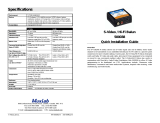Page is loading ...

Specifications
Specifications Analog Audio Digital Audio
Environment
Balanced line level or microphone
analog audio
Balanced line level digital audio
Signal Amplitude
2.3 Vp-p 2 – 7Vp-p
Polarity Sensitive
Phase polarity sensitive Not polarity sensitive
Impedance
Output: 600 Ω Input: 600-20kΩ 110 Ω
Signal type
Professional balanced analog line level
or microphone
Professional balanced digital line level
Maximum Distance via Cat5
UTP
Line level: 5,000 ft (1.5 km)
Passive Mic level: 3,000 ft (914m)*
* Active microphone supported.
Requires ground pin connected at both
ends. Distance unspecified.
Sampling Rate Distance
32 kHz 1,400ft (426m)
44.1 kHz 1,300ft (396m)
48 kHz 1,250ft (381m)
96 kHz unspecified
Frequency response
DC to 6 MHz
Pro Audio Devices
mixers, routers, switchers, format converters, splitters, distribution amplifiers,
boosters, receivers, encoders, CD players, DAT recorders, microphone pre-amps,
compressors, passive microphones, equalizers, active loudspeakers, public address
systems, rental and staging equipment.
Transmission
Transparent to the user.
Insertion Loss (per pair)
Less than 1 dB /pair from DC to 6 MHz
Return Loss
Less than 15dB from DC to 6 MHz
Common Mode Rejection
(CMMR)
Greater than 45 dB
Cable – UTP
24 gauge or lower solid copper twisted pair wire impedance: 100 Ω at 1 MHz.
Maximum capacitance: 20 pf/foot. Attenuation: 6.6 dB/1000 ft at 1 MHz
Connectors
XLR3-M or XLR3-F depending on model
Two (2) screw terminals for signal
One (1) screw terminal for optional shield (ground)
Pin Configuration
XLR3 Signal UTP
Pin 1 Shield Gnd (optional)
Pin 2 Positive Tip [T]
Pin 3 Return Ring [R]
Cable Strain Relief
Threaded and tapered cable grip mechanism.
Temperature
Operating: 0° to 55° C. Storage:-20° to 85°C. Humidity: 95% non-condensing
Enclosure
Fire retardant plastic. UL94-V0
Dimensions
1.875” x 1” diameter (4.76 cm x 2.54 cm diameter) plus 5” (12.7cm) XLR3
lead
Weight
2.64 oz (75 gms)
Standards
AES/EBU 1982, AES-1992, ANSI S.40-1992, IEC-958
Regulatory
FCC, CE.
Warranty
Lifetime
Order Information
500025 MonoPro XLR, XLR3-M
500026 MonoPro XLR, XLR3-F
5450 Cote de Liesse, Montreal,
Quebec, Canada, H4P 1A5
Tel.: +1 (514) 905-0588 Fax: +1 (514) 905-0589
Toll Free (North America): (877) 689-5228
E-mail: [email protected] URL: www.muxlab.com
94-000343-B SE-000572-B
VideoEase MonoPro™ XLR
(500025, 500026)
Installation Guide
Introduction
The MonoPro™ XLR (500025, 500026) allows a standard AES analog or digital
audio channel to be connected via Cat5 unshielded twisted pair cable (UTP) in the
professional audio environment. The product features heavy duty cable strain relief
for rugged environments such as rental and staging and is available with male or
female locking XLR3 connectors for added cabling versatility.
Installation
To install the MonoPro XLR, perform the following steps:
1. The MonoPro™ XLR works in pairs. Depending on the number of audio
signals to be transmitted, use one pair of MonoPro XLR adapters for each
audio signal. For example; mono audio – two (2) adapters, stereo audio - four
(4) adapters, etc.
2. Identify the pin configuration of the adapter. One twisted pair is required for
each audio connection with an optional connection for shield. MonoPro™ XLR
is polarity sensitive. Therefore, please ensure straight-through polarity.
3. Remove the adapter cover by inserting a screwdriver at the lower edge of the
cover.

4. Loosen the cable strain relief nut and feed the Cat5 cable through the opening
into the adapter.
5. Strip back about 1” of the cable jacket and expose about ¼” of copper wire at
the end of the appropriate wires.
6. Connect the UTP wires to the screw terminal blocks, respecting the wiring
polarity. If STP is used, connect the drain wire to the Ground terminal.
7. Tighten the cable strain relief nut at the end of the adapter.
8. Plug the MonoPro™ XLR into the XLR3 connector of the audio source
equipment.
9. Repeat steps 4 to 6 for the MonoPro XLR at the receiver side.
10. Plug the second MonoPro™ XLR into the XLR3 connector of the audio
receiver equipment at the remote side.
11. Complete the connection between the two adapters, using standard UTP cable,
connector blocks and modular wall outlets as required. The following diagram
shows a typical connection.
12. Power-on the audio equipment and check the audio quality. The audio should
be clear within the maximum specified distances. The following diagram
shows a typical application.
Troubleshooting
The following table describes some of the symptoms, probable causes and possible
solutions in regard to the installation of the MonoPro XLR Balun. If you still
cannot diagnose the problem, please call MuxLab Customer Technical Support at
877-689-5228 (toll-free in North America) or +1 514-905-0588 (International).
Symptom Probable Causes Possible Solutions
Poor audio quality 1. EMI interference. Check that wiring is not too close to
transformers and ballasts. Use STP if
necessary.
2. Split pair Check if the UTP pairs are split and
correct. Each signal pair must be
twisted.
No audio 1. Power-off. Check power supply.
2. Open contact Check wiring to ensure continuity
3. Defective balun Change MonoPro™ XLR for another
pair.
Audio weak 1. Distance exceeded Check DC loop resistance and verify if
distance spec is exceeded. Reduce cable
length or eliminate high-loss
components.
2. Lower grade UTP cable
is introducing high
signal losses.
Use signal repeater for extended
distance.
Replace cable by higher grade.
Missing digital
audio channels
1. Cabling problem
between the
decoder/amp and the
audio speakers.
Check audio speaker cabling.
Intermittent static
noise on one or
more digital audio
channels.
1. Distance exceeded or
unusual cable
attenuation
Check cable distance and cable grade.
/






